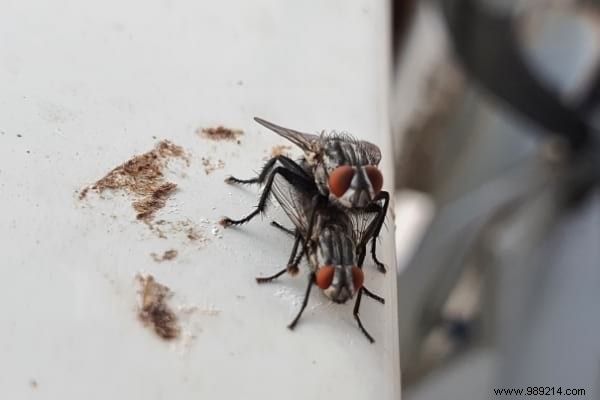
Today I'm explaining where flies lay their eggs in our dwellings.
Because hunting them is good, but preventing them from sowing their eggs is even better!
Understanding their feeding habits and breeding grounds is very important if you want to get to the root of the problem.
The proof, since I spotted where their favorite spawning spots were, I'm not bothered at all anymore.
These pests no longer invade my living space at all.
Do you also want to know their secrets?
Find out where flies lay their eggs in the house and how to get rid of them quickly. Watch:


Most insects begin their life cycle by laying eggs in different places.
And these egg-laying spots depend on the fly species and their preferred habitat.
By knowing where to find fly eggs, you therefore prevent future invasions!
For example, fruit or house flies reproduce in certain places in the house.
So it is important to get rid of these sites to eliminate these harmful.
I therefore show you, depending on the type of fly, where to look!
Look.

House fly eggs are not hard to find.
They usually lay eggs in moist, decaying organic matter.
Their eggs are found in garbage, rotten food or even in feces.
One of the favorite breeding grounds for these flies is in uncovered garbage cans!
They are attracted to all kinds of human food, animal food and food waste.
Poor hygiene, torn mosquito nets or cracks in windows and doors are all factors of invasion.
Elongated or pale in color, the eggs appear in clusters and hatch soon after the female has laid eggs.

As their name suggests, fruit flies often infest homes from overripe or rotting fruit.
They also appreciate fermented products such as beer, alcohol and wine.
But fruit flies can also breed and grow in other places.
They particularly like our drain pipes, garbage disposals, garbage cans...
Fruit flies are capable of laying up to 500 eggs at a time and hatch very quickly (in 24/30H)!
So, regularly wipe down countertops, sinks and take out your trash.
And of course, discard any overripe or damaged fruit.
I advise you to keep your fruits and vegetables in the refrigerator.

Drain flies, also called sewer flies, lay their eggs in drains that are not well maintained.
They are often found near sewers where the larvae feed on muddy organic matter.
Dirty standing water increases the chances of these pests reproducing and growing in the home.
If these flies are present, it's definitely a dirty or clogged pipe or drain.
So, maintain your pipes regularly with white vinegar.

Blow fly eggs develop inside rotten or rancid meat.
They are also present in animal feces or in decomposing bodies.
These pests enter homes through open doors, windows or cracks in the walls.
These flies are in constant search of food.
Once inside, they find a meal and start laying eggs on its surface.
Be careful, these flies transmit infections to humans by contaminating food!
You will understand, to avoid having this type of fly at home, do not leave meat outside for too long!

Mushroom flies are attracted to potted plants or cut garden flowers.
These pests therefore swarm around plants, windows and places exposed to light.
Their main food sources are fungi, plant roots and other organic matter.
To prevent the appearance of these flies, do not overwater your houseplants.
Also, don't hesitate to throw away infested plants.
Now that you know where to look inside the house, let's look at the exteriors.
Other pest species, such as stable or cluster flies, lay eggs outdoors.
The disappearance of their preferred habitats prevents these pests from multiplying.

Cluster flies, also called cluster flies, are household pests.
Their life cycle begins when the female lays her eggs in the ground in late summer or early fall.
These eggs hatch within a few days, after which the larvae enter the body cavities of earthworms.
When winter comes, they take refuge in calm and warm places to hibernate.
They are therefore often found in the attics or hollow walls of houses.
When they feel the time has come to end their winter break, they resume their flight activity.

Stable flies, also called sooty flies, lay their eggs in specific places.
In the wastes of animals, decaying plants, or other rotting matter.
They are therefore mainly found in the countryside around barns, stables or sheepfolds.
Be aware that females need blood to develop their eggs.
They can therefore bite livestock or people, hence a risk of disease transmission!
Preventing flies from breeding is the first step to not suffering an invasion.
So to stop their development, follow these simple basic rules.
- Keep your kitchen clean, without storing old foodstuffs and old waste.
- Get rid of fruits that are a little overripe or even rotten.
- Don't forget to pick up the excrement of your pets (dogs, cats, rabbits...) in the garden or worse in the house.
- Equip yourself with mosquito nets to put on the windows.
- And above all, eliminate their food sources and breeding sites.
This is the best way to prevent or control an infestation of flies in the house.

One or two flies here and there in the house is nothing to worry about.
But if larger numbers of flies are buzzing around you, a nest is definitely not far away!
It is therefore necessary to identify the places favorable to their feeding and reproduction.
As already mentioned, garbage cans, toilets, plants and kitchens are their favorite places.
Stagnant water and rotting food are also their favorite places.
Flies mostly congregate in these same places.
Finding their place of food means finding the place of laying where the maggots will be born.